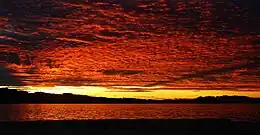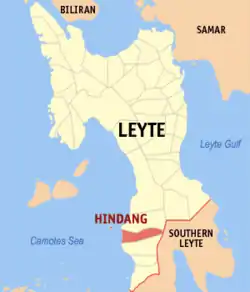Hindang | |
|---|---|
| Municipality of Hindang | |
 Sunset at Cuatro Islas | |
 Flag | |
 Map of Leyte with Hindang highlighted | |
OpenStreetMap | |
.svg.png.webp) Hindang Location within the Philippines | |
| Coordinates: 10°26′02″N 124°43′40″E / 10.4339°N 124.7278°E | |
| Country | Philippines |
| Region | Eastern Visayas |
| Province | Leyte |
| District | 5th district |
| Barangays | 20 (see Barangays) |
| Government | |
| • Type | Sangguniang Bayan |
| • Mayor | Betty A. Cabal |
| • Vice Mayor | Elpidio B. Cabal Jr. |
| • Representative | Carl Nicolas C. Cari |
| • Councilors | List |
| • Electorate | 14,979 voters (2022) |
| Area | |
| • Total | 50.04 km2 (19.32 sq mi) |
| Elevation | 4.7 m (15.4 ft) |
| Highest elevation | 202 m (663 ft) |
| Lowest elevation | 0 m (0 ft) |
| Population (2020 census)[3] | |
| • Total | 20,849 |
| • Density | 420/km2 (1,100/sq mi) |
| • Households | 5,290 |
| Economy | |
| • Income class | 5th municipal income class |
| • Poverty incidence | 23.62 |
| • Revenue | ₱ 106 million (2020) |
| • Assets | ₱ 380.5 million (2020) |
| • Expenditure | ₱ 119.2 million (2020) |
| • Liabilities | ₱ 61.73 million (2020) |
| Service provider | |
| • Electricity | Leyte 4 Electric Cooperative (LEYECO 4) |
| Time zone | UTC+8 (PST) |
| ZIP code | 6523 |
| PSGC | |
| IDD : area code | +63 (0)53 |
| Native languages | Cebuano Tagalog |
Hindang (IPA: [hɪn'daŋ]), officially the Municipality of Hindang (Cebuano: Lungsod sa Hindang; Waray: Bungto han Hindang; Tagalog: Bayan ng Hindang), is a 5th class municipality in the province of Leyte, Philippines. According to the 2020 census, it has a population of 20,849 people.[3]
In the north, it borders the town of Inopacan and Hilongos in the south. Himokilan is a part of Cuatro Islas (The Four Islands), in which the other three (3) remaining islands are under the administrative jurisdiction of the municipality of Hindang.[5]
Geography
Barangays
Hindang is politically subdivided into 20 barangays. [6] Each barangay consists of puroks and some have sitios.
In 1957, the sitios of Canhaayon, Capudlosan, Himokilan, Anolon, Mahilum, Baldoza, and Tagbibi were converted into barrios.[7]
- Anahaw
- Anolon
- Baldoza
- Bontoc
- Bulacan
- Canha-ayon
- Capudlosan
- Himacugo
- Doos Del Norte
- Doos Del Sur
- Himokilan Island
- Katipunan
- Maasin
- Mabagon
- Mahilum
- Poblacion 1
- Poblacion 2
- San Vicente
- Tabok
- Tagbibi
Climate
| Climate data for Hindang, Leyte | |||||||||||||
|---|---|---|---|---|---|---|---|---|---|---|---|---|---|
| Month | Jan | Feb | Mar | Apr | May | Jun | Jul | Aug | Sep | Oct | Nov | Dec | Year |
| Mean daily maximum °C (°F) | 28 (82) |
29 (84) |
29 (84) |
30 (86) |
30 (86) |
30 (86) |
29 (84) |
29 (84) |
29 (84) |
29 (84) |
29 (84) |
29 (84) |
29 (84) |
| Mean daily minimum °C (°F) | 22 (72) |
22 (72) |
22 (72) |
23 (73) |
25 (77) |
25 (77) |
25 (77) |
25 (77) |
25 (77) |
24 (75) |
24 (75) |
23 (73) |
24 (75) |
| Average precipitation mm (inches) | 78 (3.1) |
57 (2.2) |
84 (3.3) |
79 (3.1) |
118 (4.6) |
181 (7.1) |
178 (7.0) |
169 (6.7) |
172 (6.8) |
180 (7.1) |
174 (6.9) |
128 (5.0) |
1,598 (62.9) |
| Average rainy days | 16.7 | 13.8 | 17.3 | 18.5 | 23.2 | 26.5 | 27.1 | 26.0 | 26.4 | 27.5 | 24.6 | 21.0 | 268.6 |
| Source: Meteoblue[8] | |||||||||||||
Demographics
|
| |||||||||||||||||||||||||||||||||||||||||||||||||||
| Source: Philippine Statistics Authority [9][10][11][12] | ||||||||||||||||||||||||||||||||||||||||||||||||||||
In the 2020 census, the population of Hindang, Leyte, was 20,849 people,[3] with a density of 420 inhabitants per square kilometre or 1,100 inhabitants per square mile.
Economy
History
The official name of the municipality has always been Hindang since the town's establishment in 1860. Legend has it that the name was derived from a very large tree named "Indang" which used to stand in the northern part of the town. It was told that the tree was "enchanted" because there were stones of fairies or beautiful damsels with long flowing hair basking under it on moonlit nights. There was also a ghostly tale about a man who committed suicide by hanging himself from one of its branches. When his body was discovered, the place became haunted by a voice in agony, a long silence then mournful weeping followed by a remorseful sigh.[20]
The founders of the town were Rev. Fr. Bales, the parish priest at that time, Mission Alejandro, a prominent citizen, and the capitanes Damos Bañez, Irong Ballener, and Beo Abddies.
Like other coastal towns, Hindang suffered very much from Moro depredations. However, despite the heavy lootings, the town managed to recover each time and was able to rebuild what the pirates carried off or destroyed.
The townsfolk of Hindang are essentially musical-minded and even during the Spanish times, they used to hold frequent band concerts. Dramas portraying the rivalry between the Moros and the Christians for supremacy were often depicted. "Pastores" and "Tombolas" were held especially during the Christmas season. Horse races were held during Sundays and these were sources of entertainment for the Spanish residents who were not averse to making bets on their favorites.
More public schools were established during the American regime. The government offices that used to be held by Americans were slowly being opened to deserving Filipinos. At the outbreak of the First World War, many Hindang residents volunteered for service. They were sent to Manila for training before finally being shipped to the fronts.
In 1911, a long drought and one of the most destructive typhoons to hit the province caused near famine to the impoverished population. Some of the leaders during this period who helped put Hindang back on the road to recovery were Don Miguel Abamo, Don Leon Fernandez, Marciano Rodriguez, and Estanislao Picson. Capitan Nemesio Delalamon was the last of the presidentes during this period.
Numerous townsfolk of Hindang suffered physical torture during the Japanese occupation from 1942 to 1944. Two guerrilla factions were fighting for supremacy. Only the timely mediation of Colonel Kangleon prevented the guerrilla groups from destroying each other. Unified by the Colonel, the group helped destroy the hold of the Japanese on the town. The long sufferings from the Japanese occupation finally came to an end when the Americans came to liberate the country in October 1944.
On July 4, 1946, the granting of independence to the Philippines led to the initiation of government projects like irrigation systems, schoolhouses, and a public market.[20]
Education
- Saint Michael College of Hindang Leyte (1948)
References
- ↑ Municipality of Hindang | (DILG)
- ↑ "2015 Census of Population, Report No. 3 – Population, Land Area, and Population Density" (PDF). Philippine Statistics Authority. Quezon City, Philippines. August 2016. ISSN 0117-1453. Archived (PDF) from the original on May 25, 2021. Retrieved July 16, 2021.
- 1 2 3 Census of Population (2020). "Region VIII (Eastern Visayas)". Total Population by Province, City, Municipality and Barangay. Philippine Statistics Authority. Retrieved 8 July 2021.
- ↑ "PSA Releases the 2018 Municipal and City Level Poverty Estimates". Philippine Statistics Authority. 15 December 2021. Retrieved 22 January 2022.
- ↑ "Cuatro Islas: The Gems of Hindang". Choose Philippines. Retrieved January 10, 2019.
- ↑ "Province:". PSGC Interactive. Quezon City, Philippines: Philippine Statistics Authority. Retrieved 12 November 2016.
- ↑ "An Act Converting the Sitios of Kanhaayon, Kapudlosan, Himokilan, Anolon, Mahilom, Baldoza and Tagbibi, Municipality of Hindang, Province of Leyte, into Barrios of Said Municipality". LawPH.com. Retrieved 2011-04-12.
- ↑ "Hindang: Average Temperatures and Rainfall". Meteoblue. Retrieved 9 February 2020.
- ↑ Census of Population (2015). "Region VIII (Eastern Visayas)". Total Population by Province, City, Municipality and Barangay. Philippine Statistics Authority. Retrieved 20 June 2016.
- ↑ Census of Population and Housing (2010). "Region VIII (Eastern Visayas)" (PDF). Total Population by Province, City, Municipality and Barangay. National Statistics Office. Retrieved 29 June 2016.
- ↑ Censuses of Population (1903–2007). "Region VIII (Eastern Visayas)". Table 1. Population Enumerated in Various Censuses by Province/Highly Urbanized City: 1903 to 2007. National Statistics Office.
{{cite encyclopedia}}: CS1 maint: numeric names: authors list (link) - ↑ "Province of". Municipality Population Data. Local Water Utilities Administration Research Division. Retrieved 17 December 2016.
- ↑ "Poverty incidence (PI):". Philippine Statistics Authority. Retrieved December 28, 2020.
- ↑ "Estimation of Local Poverty in the Philippines" (PDF). Philippine Statistics Authority. 29 November 2005.
- ↑ "2003 City and Municipal Level Poverty Estimates" (PDF). Philippine Statistics Authority. 23 March 2009.
- ↑ "City and Municipal Level Poverty Estimates; 2006 and 2009" (PDF). Philippine Statistics Authority. 3 August 2012.
- ↑ "2012 Municipal and City Level Poverty Estimates" (PDF). Philippine Statistics Authority. 31 May 2016.
- ↑ "Municipal and City Level Small Area Poverty Estimates; 2009, 2012 and 2015". Philippine Statistics Authority. 10 July 2019.
- ↑ "PSA Releases the 2018 Municipal and City Level Poverty Estimates". Philippine Statistics Authority. 15 December 2021. Retrieved 22 January 2022.
- 1 2 "History of Hindang". Naval Diving. Retrieved 2020-04-25.
External links
- Philippine Standard Geographic Code
- Philippine Census Information
- Local Governance Performance Management System